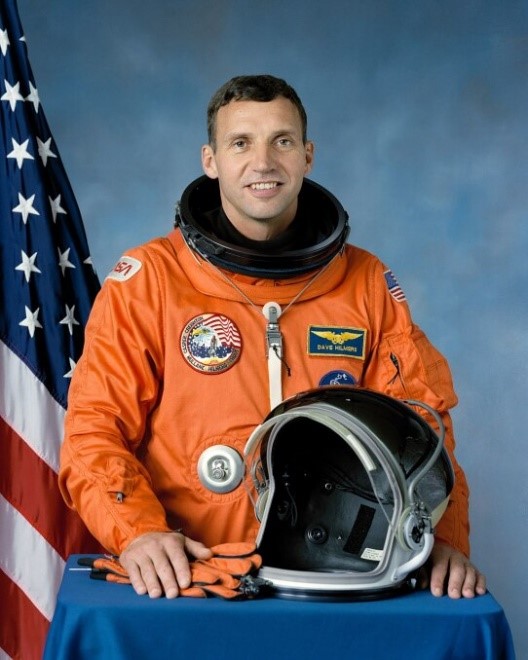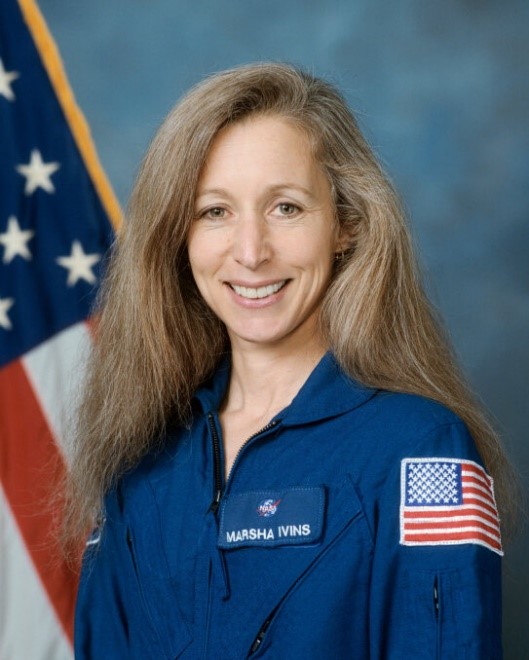The Astronaut Scholarship Foundation’s Curt Brown has announced the 2024 U.S. Astronaut Hall of Fame inductees. Veteran astronauts David Hilmers and Marsha Ivins will join the 107 astronauts who have been inducted into the U.S. Astronaut Hall of Fame, located at Kennedy Space Center Visitor Complex, since its creation more than 30 years ago.
“These two veterans of the space program have demonstrated outstanding accomplishments in furthering NASA’s mission of exploration and discovery,” said Brown, board chairman of the Astronaut Scholarship Foundation, which stewards the selection process. “Both Hilmers and Ivins represent the committed spirit of exploration, bravery, and teamwork that make our space program a continued success. We are proud and honored to have them join the ranks of the space pioneers recognized in the U.S. Astronaut Hall of Fame at Kennedy Space Center Visitor Complex.”
An official ceremony and gala will take place at Kennedy Space Center Visitor Complex on June 1, 2024. Set against the historic and stunning backdrop of the Space Shuttle Atlantis®, the ceremony will be attended by several astronaut legends. Following the induction, the newest Hall of Fame members will be celebrated at an evening black-tie event hosted by the Astronaut Scholarship Foundation.
Both Hilmers and Ivins had careers with NASA beyond the time they served as astronauts, with Hilmers working with NASA for 12 years, and Ivins for 37 years. Each has continued to work in their respective fields with a focus on their love of space and science.
David Hilmers, Colonel, USMC, Retired, STS-51J, STS-26, STS-36, STS-42

David Hilmers was born in Clinton, Iowa but considers nearby DeWitt, Iowa his hometown. He attended Cornell College and graduated summa cum laude with a degree in mathematics in 1972. He enlisted in the United States Marine Corps in 1971 and was commissioned a second lieutenant upon graduation. He completed naval flight officer training and A-6 Intruder training the next year. He served with all three Marine Corps aviation wings and with the Second Marine Division as a forward air controller. He attended the Naval Postgraduate School and received a Master of Science in electronics engineering and a degree in electrical engineering. At the time of his selection as an astronaut in 1980, he had recently completed a tour with the 1st Marine Aircraft Wing.
During his 12-year career with NASA, he served in a variety of roles including shuttle software testing, EVA suit development, capsule communicator for six shuttle flights, and as the head of the Mission Development branch of the astronaut office.
He flew as a mission specialist on STS 51-J, a Department of Defense (DOD) mission, the inaugural flight of space shuttle Atlantis in 1985. He was selected to be a mission specialist on the return to flight crew, STS-26, after the Challenger tragedy. This mission returned America to space and successfully launched a TDRS communications satellite. His next mission was another DOD flight in 1990. The mission profile took the shuttle to the highest inclination, 62.0 degrees, of any U.S. crewed spaceflight to date.
After his third shuttle mission, he decided to pursue his life-long ambition to become a physician. The week of his scheduled medical school entrance exams, in April 1992, astronaut Sonny Carter tragically died. He was asked to replace Sonny on STS-42, the International Microgravity Lab-1 (IML-1) mission, scheduled to launch in nine months. He accepted and began to train on the 60+ experiments that were manifested on IML-1. Just four weeks before launch, he was accepted into Baylor College of Medicine. Six months after landing in February 1992, Hilmers retired from NASA as a Colonel in the Marine Corps and began a new mission as a medical student.
He completed medical school and his residency at Baylor College of Medicine, finishing both the internal medicine and pediatrics programs, and obtained a Master of Public Health degree.
Hilmers is currently a Professor of Internal Medicine and Pediatrics at Baylor and serves as the Chief Medical Officer for an Australian-based NGO, Hepatitis B Free (HBF) which was founded by his wife, Dr. Alice Lee. Since 2013, HBF has worked with governments and local partners to establish hepatitis treatment programs in low income countries. His true love has always been volunteer medical work and disaster relief in low-resource countries and has served in nearly 60 countries. Notably, he has worked in areas of conflict (Iraq and Ukraine); as an early responder after typhoons, earthquakes, and tsunamis; in refugee camps across the globe; and in epidemics such as the Ebola outbreak in West Africa.
Hilmers remains involved with the space program. He served on the User Committee of the National Space Biomedical Research Institute throughout its existence. He has been a faculty member in Baylor College’s Center for Space Medicine since its inception. He holds a position with NASA as the Exploration Medicine technical lead for the Clinical Science Team. He has been involved in creating tools to help determine the requirements for medical expertise and resources on lunar and Martian space missions.
David and Alice, a gastroenterologist, live in Sydney, Australia, and regularly volunteer in the Asia-Pacific region. He returns periodically to Houston for teaching and clinical work at Baylor. His oldest son, Matthew, works as a manager in Houston, and his younger son, Daniel, is a pastor in Warsaw, Poland.
Marsha Ivins, STS-32, STS-46, STS-62, STS-81 and STS-98

After graduating from the University of Colorado with a bachelor of science in aerospace engineering, Ivins was hired by Abbot Laboratories to work as a bio-medical engineer in their hospital products division. In 1974 she joined the Lyndon B. Johnson Space Center in Houston, TX to work in human factors and man-machine engineering helping to develop the space shuttle orbiter cockpit layout, displays and controls, and the Head-Up Display. In 1980, Ivins was reassigned as a flight test engineer on the Shuttle Training Aircraft, the aircraft used to train all pilots in the shuttle’s final landing phase. She served as a flight engineer during training flights, and during flight tests of the final approach and landing software including the HUD, night landing techniques, and approaches to all designed Orbiter landing areas in the U.S. She was also assigned as a pilot on the NASA administrative aircraft. She holds a multi-engine Airline Transport Pilot License with Gulfstream-1 type rating, single-engine airplane, land, sea, and glider commercial licenses, and airplane, instrument, and glider flight instructor ratings. She has logged over 7,000 hours in civilian and NASA aircraft.
Ivins was selected as an astronaut in the class of 1984 as a mission specialist. A veteran of five space flights, STS-32 in 1990, STS-46 in 1992, STS-62 in 1994, STS-81 in 1997, and STS-98 in 2001; she has logged over 1,318 hours in space.
During her tenure in the astronaut office, Ivins supported the Space Shuttle and Space Station Programs in all areas of operational crew interface and was the astronaut office expert in flight crew equipment, habitability, imagery (introducing new films and camera systems), and stowage. She also provided crew representation to program safety review boards and program decisional boards, and crew support to launch checkout operations at the Kennedy Space Center. In her last four years with the agency, Ivins led the astronaut office team supporting the Constellation Program and the Commercial Crew Development initiative.
In 2010, Ivins retired after a 37-year career with NASA. Since then, she has done flight test work for aircraft sensor systems, served as a consultant to the last IMAX space film documentary released in 2015, consulted on commercial spacecraft software independent verification and validation, and supported proposal work on a human lunar landing vehicle from the crew operations and human systems integrations perspective. Ivins continues to support human space exploration endeavors and is currently serving as Director of Human Systems Integration at Sophic Synergistics, a human-centered design consulting firm in Houston, TX.
The U.S. Astronaut Hall of Fame was spearheaded more than 30 years ago by the six surviving Mercury 7 astronauts. In November 2016, a new U.S. Astronaut Hall of Fame opened at Kennedy Space Center Visitor Complex, as part of the Heroes & Legends attraction.
U.S. Astronaut Hall of Fame Induction Process and Eligibility
Each year, inductees are selected by a committee of Hall of Fame astronauts, former NASA officials, flight directors, historians and journalists. The process is administered by the Astronaut Scholarship Foundation. To be eligible, an astronaut must have made his or her first flight at least 17 years before the induction. Candidates must be a U.S. citizen and a NASA-trained commander, pilot or mission specialist who has orbited the Earth at least once.
The Astronaut Scholarship Foundation (ASF) participated in creating a venue where space travelers could be remembered – the U.S. Astronaut Hall of Fame, which opened in 1990. Today, the foundation serves as a consultant for the Hall of Fame, which includes conducting the selection process of astronauts for enshrinement by an outside committee. The Foundation’s mission is to aid the U.S. in retaining its world leadership in science and technology by providing scholarships to extraordinary college students who exhibit motivation, imagination, and exceptional performance in these fields, and facilitate programs to educate the public about the impact and importance of science, technology, engineering, and math (STEM) education in the United States. Since the inception of ASF, more than $8 million in scholarships have been distributed to more than 790 exceptional students in the fields of STEM at 46 university partners across the country with support from astronauts from the Mercury, Gemini, Apollo, Skylab, Space Shuttle and Space Station programs who participate in this educational endeavor. For more information, visit www.AstronautScholarship.org.